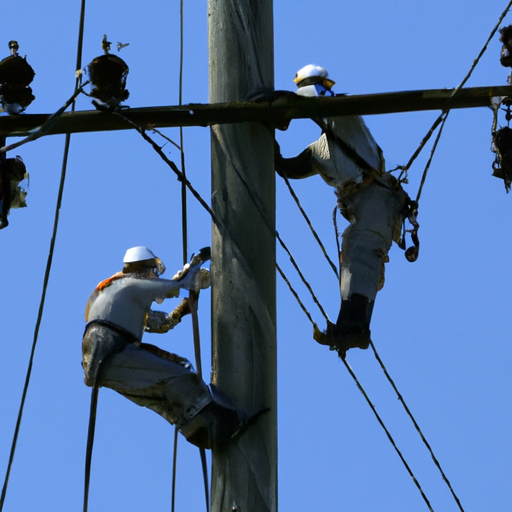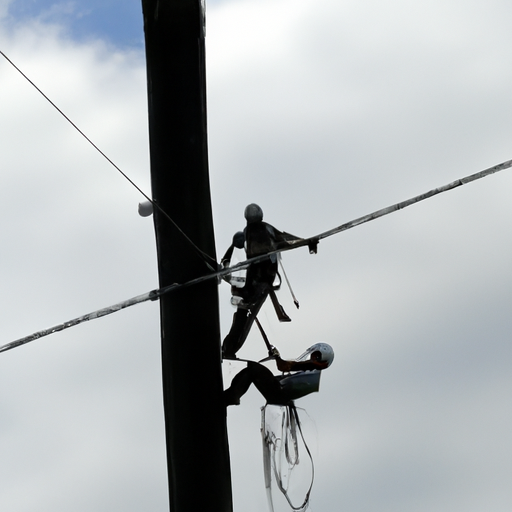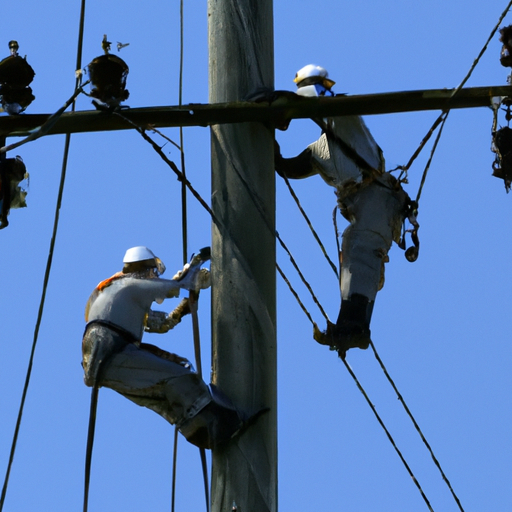So you’re curious about how linemen climb poles? Well, let me tell you, it’s quite the art. In the world of electrical power line maintenance and installation, linemen are the skilled individuals who are responsible for scaling great heights and working safely on utility poles. It’s a fascinating job that requires a unique set of skills and techniques.
In our upcoming article, “The Art of Pole Climbing: How Linemen Scale Heights,” we’ll take a deep dive into the world of these daring professionals. We’ll explore the various techniques they use to climb poles, the equipment they utilize to ensure their safety, and the physical and mental strength required for this demanding job. So if you’re intrigued by how linemen defy gravity and work at such great heights, stay tuned for our informative article that will shed light on the art of pole climbing!

The Basics of Pole Climbing
Pole climbing is an essential skill for linemen, allowing them to reach great heights to perform their job effectively. Whether it’s installing or maintaining power lines or telecommunication cables, the ability to climb a pole safely and efficiently is vital. In this article, we will explore the basics of pole climbing, including the equipment, safety measures, climbing techniques, weight management, advanced strategies, and the necessary skills to become a skilled lineman.
Understanding the Equipment
To safely climb a pole, linemen rely on specialized equipment designed specifically for this purpose. One of the most critical pieces of equipment is the pole climber, which consists of spikes or hooks that attach to the lineman’s boots. These spikes or hooks penetrate the pole, providing a secure grip and preventing slipping during the ascent.
Additionally, linemen use a body belt or harness that goes around their waist and legs. The body belt or harness is essential for attaching safety lanyards, which secure the lineman to the pole and prevent falls.
Ensuring Proper Safety Measures
Safety is paramount in pole climbing, as even a small mistake can lead to severe injuries or even death. Linemen must follow specific safety protocols, such as conducting a pre-climb inspection of the pole to check for any defects or damages. They should also ensure that their equipment is in good condition and properly adjusted before starting the climb.
Furthermore, linemen must always wear personal protective equipment (PPE), including a hard hat, safety glasses, gloves, and appropriate clothing. These protective gears safeguard against potential hazards, such as falling debris or accidental contact with live electrical wires.
Types of Poles and Their Challenges
Different types of poles pose unique challenges for linemen. Wooden poles, commonly used for distribution power lines, are known for their strength and durability. However, climbing wooden poles can be more challenging due to their irregular shape and surface. Linemen must adapt their climbing techniques to ensure a secure grip on these poles.
On the other hand, metal poles, including steel or concrete, offer a more uniform surface for climbing. However, linemen need to be cautious of potential hazards such as the presence of high-voltage lines or the risk of electrical grounding. Special considerations and safety measures must be taken when climbing metal poles.

Mastering Climbing Techniques
To climb a pole efficiently, linemen must master various climbing techniques that optimize their speed, stability, and safety. One essential aspect is using climbing gear efficiently. Linemen must regularly inspect their climbers, ensuring that the spikes or hooks are sharp and securely attached. Proper alignment and positioning of the climbers on the pole are crucial to maintain balance and prevent unnecessary strain on the legs.
Stepping and gripping techniques are also key to a successful climb. Linemen use a combination of leg muscles and upper body strength to propel themselves up the pole. The stepping technique involves driving one foot into the pole while simultaneously gripping with the other foot. This alternating movement allows for a controlled upward ascent.
Managing Weight and Balance
Maintaining weight distribution and balance throughout the climb is essential for stability and preventing falls. Linemen must distribute their weight evenly between their arms and legs, avoiding excessive strain on any one part of the body. This even weight distribution allows for a more efficient climb while reducing the risk of fatigue or muscle strain.
Additionally, linemen must navigate uneven poles, such as those with cross-arms or various attachments. The ability to maintain balance on these poles involves adjusting body positioning and carefully shifting weight to accommodate the pole’s irregularities.
Advanced Climbing Strategies
As linemen gain experience, they may employ more advanced climbing strategies to enhance their efficiency and safety. Ascending with spikes and hooks requires skill and precision, as missteps can result in injury or damage to the pole. Linemen utilize the spikes or hooks to propel themselves upward, maneuvering their body in a controlled manner.
Descending safely is equally important as climbing up. Linemen must maintain control over their descent by using their climbing gear and adopting appropriate techniques, such as sliding down with their legs or effectively bracing themselves against the pole.
Becoming a Skilled Lineman
Becoming a skilled lineman requires dedication, physical strength, and stamina. Linemen must develop core strength, leg muscles, and upper body strength through regular exercise and conditioning. This physical preparation ensures that linemen have the endurance to climb poles and perform their tasks effectively.
Gaining proficiency in pole climbing, like any skill, comes with practice. Linemen should make use of training opportunities to refine their techniques and learn from experienced climbers. Mentors and senior linemen can provide valuable guidance and knowledge to help newcomers develop into skilled linemen.
Overcoming Common Challenges
Linemen often face various challenges in their line of work. Adverse weather conditions, such as strong winds or rain, can make pole climbing even more dangerous. Proper precautions, such as wearing appropriate clothing and staying alert to changing weather patterns, must be undertaken to ensure safety in these conditions.
Electrical hazards are another significant challenge for linemen. Working near live wires demands utmost caution and adherence to safety protocols, including maintaining the required distance from energized equipment and using proper insulation techniques. Linemen must remain vigilant and knowledgeable about electrical safety to mitigate the risk of injury.
Ensuring Personal and Crew Safety
In addition to individual safety, linemen must also prioritize the safety of their team. Effective communication and coordination are critical when working as a crew. Linemen should establish clear communication protocols and use standard hand signals to relay important information. Regular safety briefings and drills help maintain crew safety awareness and ensure a cohesive approach to the job at hand.
Proper use of personal protective equipment (PPE) is vital for every lineman. Hard hats protect against head injuries, safety glasses guard against debris or particles, and gloves provide insulation and prevent cuts or burns. Linemen should regularly inspect their PPE and replace any damaged or worn-out equipment to maintain optimum protection.
Career Paths and Training
Becoming a lineman requires a combination of formal education and practical experience. Educational requirements can vary but often include a high school diploma or equivalent. Some linemen pursue vocational or technical training programs specifically designed for the electrical or telecommunications industry.
Apprenticeship programs offer a valuable opportunity for aspiring linemen to gain hands-on experience under the guidance of experienced professionals. These programs typically combine classroom instruction with practical training to build a strong foundation of knowledge and skills.
Gaining certifications in specific areas of expertise, such as powerline distribution or fiber optic installation, further enhances a lineman’s career prospects. Many professional organizations and industry groups offer certification programs that validate an individual’s expertise and commitment to safety and quality workmanship.
Conclusion
The art of pole climbing is a skill that requires a balance of physical strength, technical knowledge, and a commitment to safety. Linemen are entrusted with a critical role in ensuring the reliability and efficiency of power and telecommunication infrastructure. By understanding the equipment, following proper safety measures, mastering climbing techniques, managing weight and balance, employing advanced strategies, and continually enhancing skills, linemen become adept at scaling great heights and overcoming challenges. With dedication and the right training, individuals can embark on a rewarding career as skilled linemen, contributing to the vital infrastructure that powers modern society.




